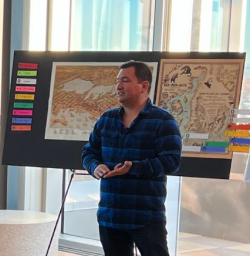Contact Us

|
Tim Grant tgrant@pci-group.com Aaron Aubin aaron@aubinconsulting.com Visit our Website: pci-group.com |
HOW IT STARTEDPCI Developments (PCI) and Low Tide Properties wanted to know how they could actively contribute to Truth and Reconciliation through their South Flatz
projects on Great Northern Way in Vancouver. As development lead and to take action
and create change within their companies, PCI co-developed an Indigenous Advisory
Committee (IAC) to advise and rethink processes that would integrate Coast Salish and
Indigenous knowledge. The IAC is committed to providing feedback on policies and
processes, and help to incorporate Indigenous knowledge and practices into their work.
The creation of the IAC has already created significant positive impacts on their work
and community. While there is still continued work to be done, PCI and the IAC are
proud of the progress that has been made and is committed to continuing to learn and
evolve how their projects can actively contribute towards advancing the collective
knowledge and respect for Coast Salish history and culture.
INDIGENOUS ADVISORY COMMITTEEPCI co-developed an Indigenous advisory committee with Cory Douglas, Ginger Gosnell-Myers, and Aaron Aubin - all accomplished Indigenous professionals and Tim Grant, President of PCI. The committees' clear objective is to affirm PCI and Low Tide's commitment to revitalizing xʷməθkʷəy̓əm, Sḵwx̱wú7mesh, and səlilwətaɬ (MST Nations) cultural identity and history in the area traditionally known as Skwachàys. This will be accomplished through the creation of new processes and practices that support the integration of Coast Salish and Indigenous knowledge throughout the South Flatz project.
INDIGENOUS ADVISORY COMMITTEE MEMBERS
|
SOUTH FLATZ PROJECT LOCATIONFor the past year, PCI has been working alongside the Indigenous Advisory Committee in preparation of its upcoming rezoning application for South Flatz which will be comprised of transit-oriented, complete communities at existing VCC-Clark Station and future GNW-Emily Carr Station on Great Northern Way. PCI and its partner Low Tide Properties, have embarked on a new path that will demonstrate how the South Flatz projects can advance reconciliation with Indigenous communities through meaningful engagement, respectful relationships, and supporting equitable access to jobs, training, and education opportunities. Source: Beasley and Associates, Planning Inc. |
CULTURAL RIBBON
In 2021, PCI took on the leadership role of bringing together developers and stakeholders for a design charrette aimed at shaping the future development of the South Flatz area. Cory Douglas and Ginger Gosnell-Myers, two Indigenous cultural advisors based in Vancouver, spearheaded the concept of Cultural Ribbon at the time, leading the conversation towards a more culturally inclusive approach to the development plans for the South Flatz area.
Source: Beasley and Associates, Planning Inc. |
SOUTH FLATZ PROJECT VISION & GUIDING PRINCIPLES
|
ABOUT THE DESIGNSouth Flatz’s guiding principles are based on the spindle whorl, which was used by Coast Salish people for weaving beautiful textiles, often into items with cultural, spiritual and social significance. The whorl is typically carved out of wood or stone with geometric, animal or human designs. Before European contact and the introduction of sheeps wool, wool was gathered from Salish “wool dogs” and sometimes combined with goat wool, goose down, and plant matter in the spinning process.
As illustrated by the graphic, the outer circles
represent the four core materials (xʷməθkʷəy̓əm, Sḵwx̱wú7mesh, and səlilwətaɬ Nations and Vancouver) which feed into the guiding principles, weaving into wool that forms the vision of the South Flatz project. |
INDIGENOUS KNOWLEDGE AS A FOUNDATIONIncorporating Coast Salish and Indigenous knowledge of the South Flatz sites was a foundational necessity, and the IAC hosted workshops with Knowledge Keepers - xʷməθkʷəy̓əm - Elder Shane Point, Sḵwx̱wú7mesh - Chief Ian Campbell, and səlilwətaɬ - Councillor Charlene Aleck. The Design Teams were introduced to the rich yet often unknown Coast Salish histories of the area and provided everyone with important knowledge that will inform the next steps of the design and development process.
NEXT STEPSThe Indigenous Advisory Committee has identified the following groups for engagement and collaboration: Musqueam, Squamish, Tsleil-Waututh Nations, Knowledge Keepers, Indigenous youth, urban Indigenous communities, City of Vancouver Indigenous Relations Office and other key groups. The Indigenous Advisory Committee is inspired for this next phase of engagements, working alongside the Design Team. The South Flatz project will host engagements concurrently, focused on external engagement and collaboration with key groups, and internal collaboration for the IAC with the Design Team. PCI and Low Tide understand that the road to Truth and Reconciliation is an evolving one and requires ongoing commitment, engagement and collaboration. |











